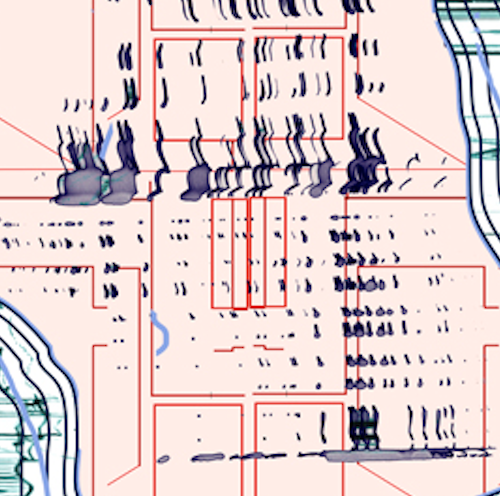
from The Desert Papers
“I am there where it speaks.” “I am where.” “Where.” Suddenly, the area of perception within and beyond the frame impregnates an entire vision. “The book begins. She writes that somewhere she will travel.” Somewhere absent, etched into microfilms of histories unspoken. “Every birth of an image,” she writes, “gathers a whole ghost.” “Poor health and corruption.” “We sought vapors good and bad.” She approaches escape through notation, putting down a past to inhabit the pause between forking paths.
Esoteric and ancient forms of gnosis reveal unknown nomad routes unfolding across the dry plains. “Use the camera as a tool to listen to the unconscious.” “Document a body with a history,” she writes, stretched taut across the smooth desert surface sutured and spliced according to cartographical properties.
First, an image perceives. This summons doubt and filling the gaps. Lenses, excerpts. She is not stationary, her methods of recording and safekeeping blow back and forth across the landscape’s periphery. “Describe how one walks, the part of the second when an individual starts to leave.” The earth beneath her feet, surviving a function, collapses horizons.
“A place in the desert,” “rainlight,” “red.” In silence hidden from her, the gelatinous dark. The reality of war is always being attacked. She’s fleeing with prismatic light, a spectacular sunset encompassing a world already embedded in this one.
Any body is a site, collection of microorganisms and cells giving birth under a duplicitous sun. Bifurcated assemblages, apertures shuttering open and close. Feeling her pulse, a system of orifices and punctums and nodes. O map of skin full of thumbtacks and pinpricks retracing the steps back.
The book intends everything and asks which you are you holding on to. The answer is always everything.
Notes
Some text in the first poem is inspired by Hélène Cixous's assertion that “Je suis là où ça parle,” or “I am there where it speaks.”
Some text in the second and third poems is inspired by Walter Benjamin's “A Short History of Photography,” where he writes that it is possible “to describe the way somebody walks, but it is impossible to say anything about that fraction of a second when a person starts to walk” and that “[photography] with its various aids (lenses, enlargements) can reveal this moment. Photography makes aware for the first time the optical unconscious, just as psychoanalysis discloses the instinctual unconscious.”
Julia Madsen is a multimedia poet and educator. She received an MFA in Literary Arts from Brown University and is a doctoral student in English/Creative Writing at the University of Denver. She is the video editor at Reality Beach, and her first book, The Boneyard, The Birth Manual, A Burial: Investigations into the Heartland, is forthcoming from Trembling Pillow Press. Her poems and multimedia work have appeared or are forthcoming in jubilat, Drunken Boat, Caketrain, Flag+Void, Word for/Word, Cloud Rodeo, Small Po[r]tions, Deluge, Dreginald, Tagvverk, Alice Blue Review, Devil's Lake, Versal,, Cartridge Lit, Cutbank, Black Warrior Review, TL;DR Magazine, PoetrySeen, Dream Pop Press, and elsewhere.